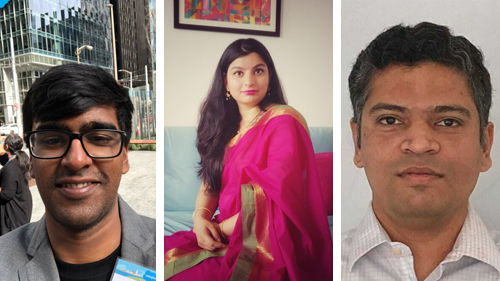Salesforce Solution Engineers (SE) are not your regular engineers. They don't just work with technology, but go one step beyond. They marry technology and business goals to help customers see true business impact.
Account Executives (AE) build customer relationships and focus on sales, while SEs play the important role of helping customers find and understand the right tech solutions for their businesses.
To understand what they do, we spoke to three Solution Engineers from Salesforce India.
- Ketan Chaudhari - Lead Solution Engineer, Commercial Business Unit
- Nivedita Sharma - Senior Solution Engineer, Commercial Business Unit
- Anirudh Maniath - Associate Solution Engineer, ESMB
One thing we know for sure – SEs love what they do!
The passion that drives an SE


And they love getting to the bottom of things and solving problems.
Here’s a closer look at a day in the life of a Solution Engineer.
A typical day in the life of an SE is never typical
How the day begins

Before meeting a prospect, SEs start by studying them. They look for basic information like the prospect’s company size or type, industry, products or services they offer, their target customers and competitors, technologies they are currently using, and if they have been in the news lately.
Once they know the prospect, they get into rigorous discovery sessions with them to get a deeper understanding of their challenges and growth plans. After identifying the suitable Salesforce solutions that have the potential to address the prospect's needs, they get down to building a demo. These demos are often built using mock data, mimicking real-life processes and scenarios from the prospect’s business.

It gets more exciting as the day progresses


Continuing the good work despite challenges
Solution Engineers also recognised the challenges that came with remote working and tackled them head-on. When selling to businesses, especially big-ticket deals, there is a lot at stake. Communicating the true value of their solutions and convincing prospects to invest in Salesforce is harder when you are not sitting in the same room.
But customers showed faith and the will to become resilient. SEs stepped up to help businesses transform holistically through technology - beyond the simple automation of specific processes. For this, our SEs step into the end users' shoes and design processes and solutions with an eye on end user experience.
And besides being experts at what they do, SEs are also strong team players. They constantly work with multiple internal stakeholders to deliver greater value, making internal collaboration more important than ever for the success of SEs and their customers.

What the end of a successful day looks like
Solution Engineers strive to improve themselves and bring about a positive change with technology. To stay on top of their game, they consistently hone their skills by completing new Trailhead modules and mastering new product features.
The success of Solution Engineers is tightly tied to their customer’s success. So, any day they can help businesses overcome their challenges and achieve their goals is a successful day for them. They believe if customers understand how the solutions benefit them, sales will happen automatically. But whenever they get a smile or a thumbs-up from their customers, it totally makes their day!




